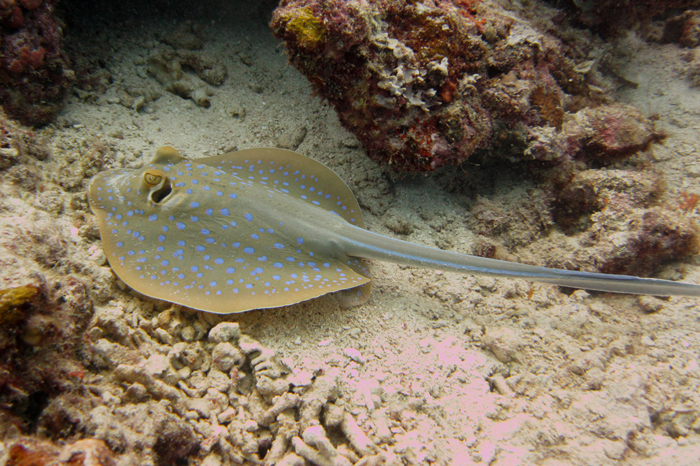Bluespotted Fantail Ray, Taeniura lymma (Forsskål 1775)

A Bluespotted Fantail Ray, Taeniura lymma - Malaysia. Source: William T. White. License: All rights reserved
On the rising tide, large schools of Bluespotted Fantail Rays often forage over shallow sandy areas, seagrass habitats and rubble mudflats, feeding on invertebrates including molluscs, polychaete worms, crabs and shrimps.
Bluespotted Fantail Ray, Taeniura lymma (Forsskål 1775)
More Info
|
Distribution |
Known in Australian waters from Ningaloo Reef, Western Australia, to northern New South Wales. Elsewhere, widespread in the Indo-West-Central Pacific. |
|
Features |
Snout rounded, angular; disc with broadly rounded outer corners, with denticles along the middle of the back in adults, thorns absent; tail stout, tapering, less than twice body length, with a broad lower caudal finfold reaching the tail tip; usually two medium-sized venomous spines well back on the tail. |
|
Size |
|
|
Colour |
|
|
Feeding |
|
|
Biology |
Reproductive mode - aplacental viviparous (ovoviviparous) with the developing embryos initially feeding on yolk, then absorbing uterine "milk" produced by the mother. Females produce up to seven young per litter, and the young are born with the characteristic blue spots. |
|
Fisheries |
Commonly caught byartisinal and small commercial fisheries around coral reefs in many parts of its range. Also traded in the aquarium industry, although Bluespotted Fantail Rays seldom thrive in captivity. |
|
Conservation |
Threatened in many parts of the world by overfishing and the destruction of reef habitats. |
|
Remarks |
|
|
Similar Species |
Differs from the Bluespotted Maskray, Neotrygon kuhlii, by its more angular disc, more slender tail, electric blue spots on the body and blue stripes along each side of the tail. |
|
Etymology |
|
|
Species Citation |
Raja lymma Forsskål 1775, Descriptiones animalium: 17. Type locality: Luhaiya, Yemen (as Lohaja), Red Sea. |
|
Author |
Bray, D.J. 2017 |
Bluespotted Fantail Ray, Taeniura lymma (Forsskål 1775)
References
Allen, G.R. 1997. Marine Fishes of Tropical Australia and South-east Asia. Perth : Western Australian Museum 292 pp. 106 pls
Allen, G.R. & Erdmann, M.V. 2012. Reef fishes of the East Indies. Perth : Tropical Reef Research 3 vols, 1260 pp.
Allen, G.R. & Swainston, R. 1988. The Marine Fishes of North-Western Australia. A field guide for anglers and divers. Perth, WA : Western Australian Museum vi 201 pp., 70 pls
Blaber, S.J.M., J.W. Young & M.C. Dunning. 1985. Community structure and zoogeographic affinities of the coastal fishes of the Dampier region of north-western Australia. Aust. J. Mar. Freshwat. Res. 36: 247-266.
Coleman, N. 1981. Australian Sea Fishes North of 30°S. Lane Cove, NSW : Doubleday Australia Pty Ltd 297 pp.
Dabruzzi, T.F., Fangue, N.A., Rummer, J.L. & Bennett, W.A. 2012. Juvenile ribbontail stingray, Taenura lymma (Forsskål, 1775) (Chondrichthyes, Dasyatidae), demonstrates a unique suite of physiological adaptations to survive hyperthermic nursery conditions. Hydrobiologia 701: 37-49. DOI: 10.1007/s10750-012-1249-z.
Forsskål, P. 1775. Descriptiones animalium avium, amphibiorum, piscium, insectorum, vermium; quae in itinere orientali observavit Petrus Forskål. Post mortem auctoris edidit Carsten Niebuhr. Adjuncta est materia medica kahirina atque tabula maris rubri geographica. Hauniae [=Copenhagen] : Mölleri 19 xxxiv [2] 164 pp.
Fowler, S.L., Cavanagh, R.D., Camhi, M., Burgess, G.H., Cailliet, G.M., Fordham, S.V., Simpfendorfer, C.A. & Musick, J.A. (eds) 2005. Sharks, Rays and Chimaeras: The Status of the Chondrichthyan Fishes. Status Survey. pp. x + 461. IUCN/SSC Shark Specialist Group, IUCN, Gland, Switzerland and Cambridge, UK.
Gloerfelt-Tarp, T. & Kailola, P.J. 1984. Trawled Fishes of Southern Indonesia and Northwest Australia. Jakarta : Dir. Gen. Fish. (Indonesia), German Tech. Coop., Aust. Dev. Ass. Bur. 406 pp.
Grant, E.M. 1975. Guide to Fishes. Brisbane : Queensland Government, Co-ordinator General’s Department 640 pp.
Grant, E.M. 2002. Guide to Fishes. Redcliffe : EM Grant Pty Ltd 880 pp.
Herre, A.W.C.T. 1953. Check list of Philippine fishes. Research Report. U.S. Fish and Wildlife Service and the U.S Department of the Interior, USA.
Kuiter, R.H. 1996. Guide to sea fishes of Australia. A comprehensive reference for divers and fishermen. Sydney, NSW, Australia : New Holland Publishers xvii, 434 pp.
Last, P.R. & Compagno, L.J.V. 1999. Family Dasyatidae. pp. 1479-1505 in Carpenter, K.E. & Niem, V.H. (eds). The Living Marine Resources of the Western Central Pacific. FAO Species Identification Guide for Fisheries Purposes. Rome : FAO Vol. 3 1397-2068 pp.
Last, P.R., Naylor, G.J.P. & Manjaji-Matsumoto, B.M. 2016. A revised classification of the family Dasyatidae (Chondrichthyes: Myliobatiformes) based on new morphological and molecular insights. Zootaxa 4139(3): 345–368. DOI: http://dx.doi.org/10.11646/zootaxa.4139.3.2 AbstractLast, P.R. & Stevens, J.D. 1994. Sharks and Rays of Australia. Canberra : CSIRO Australia 513 pp. 84 pls
Last, P.R. & Stevens, J.D. 2009. Sharks and Rays of Australia. Collingwood : CSIRO Publishing Australia 2, 550 pp.
O'Shea, O.R., Thums, M., van Keulen, M., Kempster, R.M. & Meekan, M.G. 2013. Dietary partitioning by five sympatric species of stingray (Dasyatidae) on coral reefs. Journal of Fish Biology 82: 1805–1820. doi:10.1111/jfb.12104 Abstract
Randall, J.E., Allen, G.R. & Steene, R. 1990. Fishes of the Great Barrier Reef and Coral Sea. Bathurst : Crawford House Press 507 pp. figs
Michael, S.W. 1993. Reef Sharks & Rays of the World. Sea Challengers. 88 pp.
Randall, J.E., Allen, G.R. & Steene, R. 1997. Fishes of the Great Barrier Reef and Coral Sea. Bathurst : Crawford House Press 557 pp. figs
Sainsbury, K.J., Kailola, P.J. & Leyland. G.G. 1985. Continental Shelf Fishes of Northern and North-Western Australia. Canberra : Fisheries Information Service 375 pp. figs & pls.
Smith, A.J. 1987. An ethnobiological study of the usage of marine resources by two aboriginal communities on the East Coast of Cape York Peninsula, Australia. Ph.D. Thesis. James Cook University, Townsville, 278 pp.




